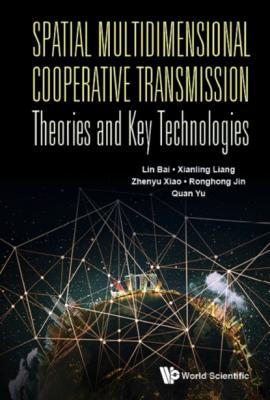Spatial Multidimensional Cooperative Transmission Theories And Key Technologies. Lin Bai
Читать онлайн.| Название | Spatial Multidimensional Cooperative Transmission Theories And Key Technologies |
|---|---|
| Автор произведения | Lin Bai |
| Жанр | Зарубежная компьютерная литература |
| Серия | |
| Издательство | Зарубежная компьютерная литература |
| Год выпуска | 0 |
| isbn | 9789811202476 |
Since N(t) is additive white Gaussian noise, nl is a white Gaussian random vector whose mean and variance are given as
where
According to the Karhunen–Loeve expansion, it can be assumed that the received signal can be represented by a space vector, i.e.
Generally, it can be assumed that sm and n are both complex vectors. In addition, n is assumed to be a circularly symmetric complex Gaussian (CSCG) random vector with E(n) = 0 and E(nnH) = Rn. For convenience,
For a given vector y, the maximum likelihood judging criteria for receiving sm(t) are fm(y) ≥ fm′(y), where m′ ≠ m, fm(y) is the mth hypothesis or the likelihood function of sm. Since the noise is assumed to be a CSCG random vector, the likelihood function of sm can be written as
Then the log-likelihood function is
Therefore, the maximum likelihood judging criteria for receiving sm(t) can be simplified as
When M = 2 which is a binary signal, the L-likelihood ratio is
As a special case, if it is assumed that nl are independent of each other, then the variances between nl are the same, which means Rn = N0I (N0 > 0). In this case, the L-likelihood ratio is
2.2Array Antenna Pattern Synthesis Technology
An antenna is a device used to transmit and receive electromagnetic energy. In many cases, the task of transmitting and receiving electromagnetic energy can be performed well by a single radiator. Various commonly used antennas, such as the vibrator antenna, microstrip antenna, horn antenna, and reflector antenna, can work independently. However, once these antenna forms are selected, their radiation characteristics are relatively fixed, such as beam pointing, beam width, gain, and so on. And this leads to the fact that a single antenna cannot work and multiple antennas need to work together to form an array antenna in some special applications, such as shaped beams, multiple beams, and scanning beams.
2.2.1Array antenna arrangement
Array antennas are generally classified according to the arrangement of the units. The array antennas with the center of each unit arranged along a line are called line arrays and the unit spacing can be equal or unequal. The array antennas with the center of each unit arranged in a plane are called planar arrays, and if all the units of the planar array are arranged according to the matrix grid, they are then called rectangular arrays. And the array antennas with the center of all units arranged on a concentric ring or an elliptical ring are called circular or elliptical arrays.
Figure 2.5 shows the arrangement of the four common array antennas. The independent units that make up the antenna array in a linear array, a planar array, and a tri-dimensional array are called antenna units or array elements. The array elements can be various types of antennas.
Fig. 2.5. Common array antennas.
The analysis and synthesis of discrete array antennas mainly depend on the following four factors: the number of array elements, the position of array elements in space, the current amplitude distribution of array elements, and the current phase distribution of array elements.
Array analysis is based on the above four factors and is used to determine the radiation characteristics of the array, including the pattern, gain, impedance, and so on. And the synthesis problem is to design the optimal array parameters (the above four factors) according to their radiation characteristics. As for the selection of the array element type, it is mainly determined by the working bandwidth, the pattern characteristics, and the polarization characteristics. In phased-array antennas, it is also related to the scan range.
In the general array antenna theory, if the mutual coupling effect between the array elements is a fixed factor with less variation, the field pattern function of the array antenna can be expressed by the product of the array factor and the array element pattern function. Let’s take a simple example to illustrate this problem, as shown in Fig 2.6.
The phase factors are (as shown in Fig. 2.6(a))
or (as shown in Fig. 2.6(b))
Fig. 2.6. Linear array antenna. (a) The origin of the coordinate system is at a unit. (b) The origin of the coordinate system is at the center of two units.
Let a = (a0, a1) be the array element coefficient, then the array factors are given as follows:
Only one phase constant difference exists between the above two expressions, which will not affect the pattern. When θ = 90°, namely in the xoy plane, the above array factor can be written as
The power pattern can be expressed as
Figure 2.7 shows the antenna pattern when a = (a0,
